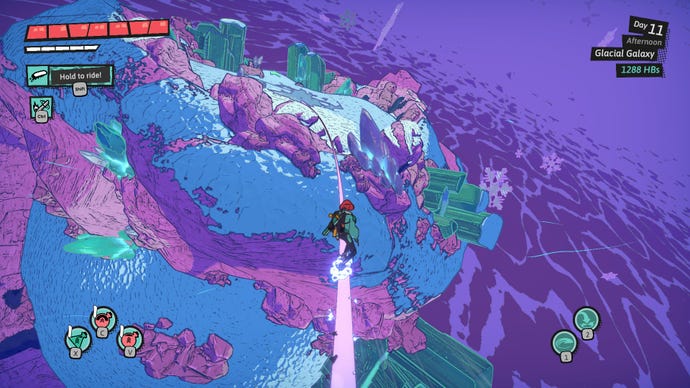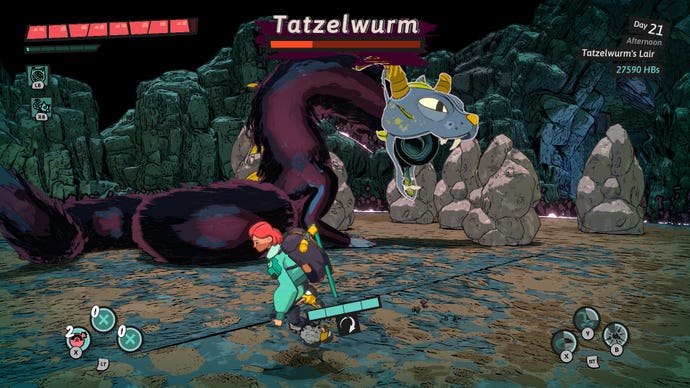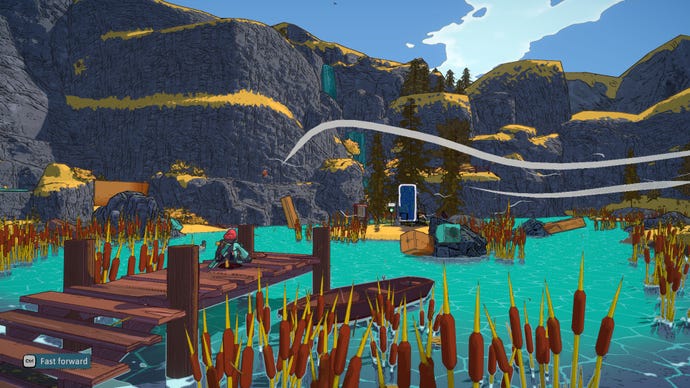Usually when a game makes me want to stop playing and go outside, it’s a bad sign, but Dungeons of Hinterberg is different. It’s an action RPG that made me want to go outside and get away from all my responsibilities to just exist for a while. Every time I finished playing, I thought about my next getaway, and even though dungeon crawling wasn’t on my vacation itinerary, Dungeons of Hinterberg made me think twice.
The protagonist Luisa is stuck in a place we’ve all been to before: Burnout City. She’s a busy lawyer who’s longing for some R&R, so she’s decided to escape to the quaint Hinterberg, a whimsical Austrian alpine village. Hinterberg is essentially a recreational holiday destination where you can hike through the wilderness, have a few beers with the locals, and slay monsters whenever the mood strikes.

Outside of the game’s base, Hinterberg, are four regions with their own dungeons. You decide which region you want to visit in the morning, fight your way through a dungeon during the day, hang out with the locals in the evening, and then end the day by returning to your hotel room. It’s a routine that you quickly settle into thanks to the special charm of each area. From the snow-capped peaks of Kolmstein with its white wonderland of majestic mountains and ice caves, to the lush meadows of Doberkogel with its cows, cable cars, and flowers – I was always taking screenshots, slowly compiling an album of holiday snaps.
Each of these regions will grant you two special magical abilities that can only be used in that area and its dungeons. For example, in Doberkogel, you can summon a giant spherical bomb that explodes through blockages and a ball and chain that you can shoot at objects and pull them towards you. The dungeons will test these abilities through a mix of combat and puzzle-solving, all presented in very different ways. You might have to navigate an underwater castle, snowboard through a wintry obstacle course, or survive a rickety minecart ride through a monster-infested cavern. When you reach the end of a dungeon, you’ll earn a satisfying travel stamp in your journal.
The puzzles are a minimally arduous game that doesn’t pose any major challenges, but their simplicity and intuitiveness still make them satisfying to solve. All the usual puzzle and environmental platforming elements are there – switch buttons, pull levers, moving platforms, etc. – but due to the regional magic of each area, the puzzle design is constantly changing. They push you to use your powers in interesting ways, and the dungeons feel like they were designed with the puzzles in mind first and foremost, with the level built around the core idea.
Magic isn’t just for solving puzzles, it’s also part of your combat arsenal, alongside many other abilities. Luisa also doesn’t carry a big sword for combat, as you’ll also have to fight your way through hordes of monsters. The way she moves feels incredibly fluid, and with a few equippable abilities, fights are often a frenzy of activity and action. I could jump in with 1, 2, 3 quick sword swings, dodge, hit them with an ice beam (thanks to Kolmstein’s magic power), and then activate my Blade Tornado, a devastating spinning ability that’s as deadly as it sounds.

The enemies are a slew of ghouls and monsters, but with a touch of alpine folklore, including various pointy-hatted gnomes, cackling witches, gnarled goats, and creepy wicker men. You’ll encounter them in groups, often placed (sometimes awkwardly) in different parts of a dungeon. You’ll fight the same types of enemies over and over again, which is a bit boring, but a constant stream of new gear and abilities keeps the fight interesting. There are also a handful of boss fights, which are one of the highlights of the game. In one, I had to fight a rabid basilisk with a giant beak and too many eyes while riding a rail on my snowboard. Krampus brawls are also a thing, so look forward to those.
Once you’ve dusted off a dungeon and all its puzzles and monsters, it’s time to head back to the central town of Hinterberg for some rest and relaxation. You can stop by the pharmacy to refill your potions, visit the local shop to buy new gear, and chat with the locals. You can choose who you want to spend time with each day, and when you reach a certain friendship level with them, you’ll get new Persona-style items and abilities. Before you spend time with people, you’ll be informed of the rewards they’ll give you, though this doesn’t matter if you really get along with a character. I’d happily spend time with Hannah, the pretty blacksmith, even if all I got was a handful of dust.
Each character has a mini-story that connects to the larger story of the game. The appearance of dungeons in Hinterberg has brought in a lot of visitors, meaning tourism is booming. With money pouring into the town, there’s a conflict between how the influx of visitors affects the locals and the bureaucracy that’s coming in everywhere. Like my friend Hannah, her shop is in danger of closing due to the pressure of corporate competition, so I’m now taking her around town to try to get people to sign a petition to keep it open. Talking to the locals and helping them solve their problems gives colour to the town and its characters rather than seeing them as vending machines spitting out items.



You may have a set routine, but I like how different the days are. Luisa wants to complete all 25 dungeons, which means you’ll have to travel back and forth between the four regions, and spending time with different locals each day brings new story beats and mini-quests. The best part is, you don’t even have to do a dungeon if you don’t want to. Instead, you can sit in different scenic spots and relax during the day, which also grants you permanent stat bonuses. I was speeding toward a lake with a dungeon portal in the center when I came across a cute wooden pier overlooking the water. I sat on the edge of the pier and stared out at the lake. The wind rustled gently through the trees, and Luisa pondered what her coworkers would be up to in her bustling office. It looked so cozy and casual, I really wanted to jump through my screen, sit down with Luisa and share a schnitzel with her.
This is what I like most about Dungeons of Hinterberg. You don’t always have to be productive, and that’s okay. When I got a little tired of delving into dungeons, I would relax during the day in different scenic locations and make an effort to hang out with the locals in the evening. I did this for an entire week in the game until I felt like beating up monsters again.
The game reaches a climax at the end of its 20-hour playtime, but for the most part, Dungeons of Hinterberg is wonderfully laid-back. There are plenty of games that romanticize leaving your busy life behind and escaping into the wilderness, but here the theme is explored in an authentic and heartfelt way. There’s a lesson here about how rest is fundamental to health and happiness, but I also love how the game communicates that. It’s a gentle, thoughtful fantasy adventure that will have you breaking out your hiking boots.
This review is based on a trial version of the game provided by the developer.